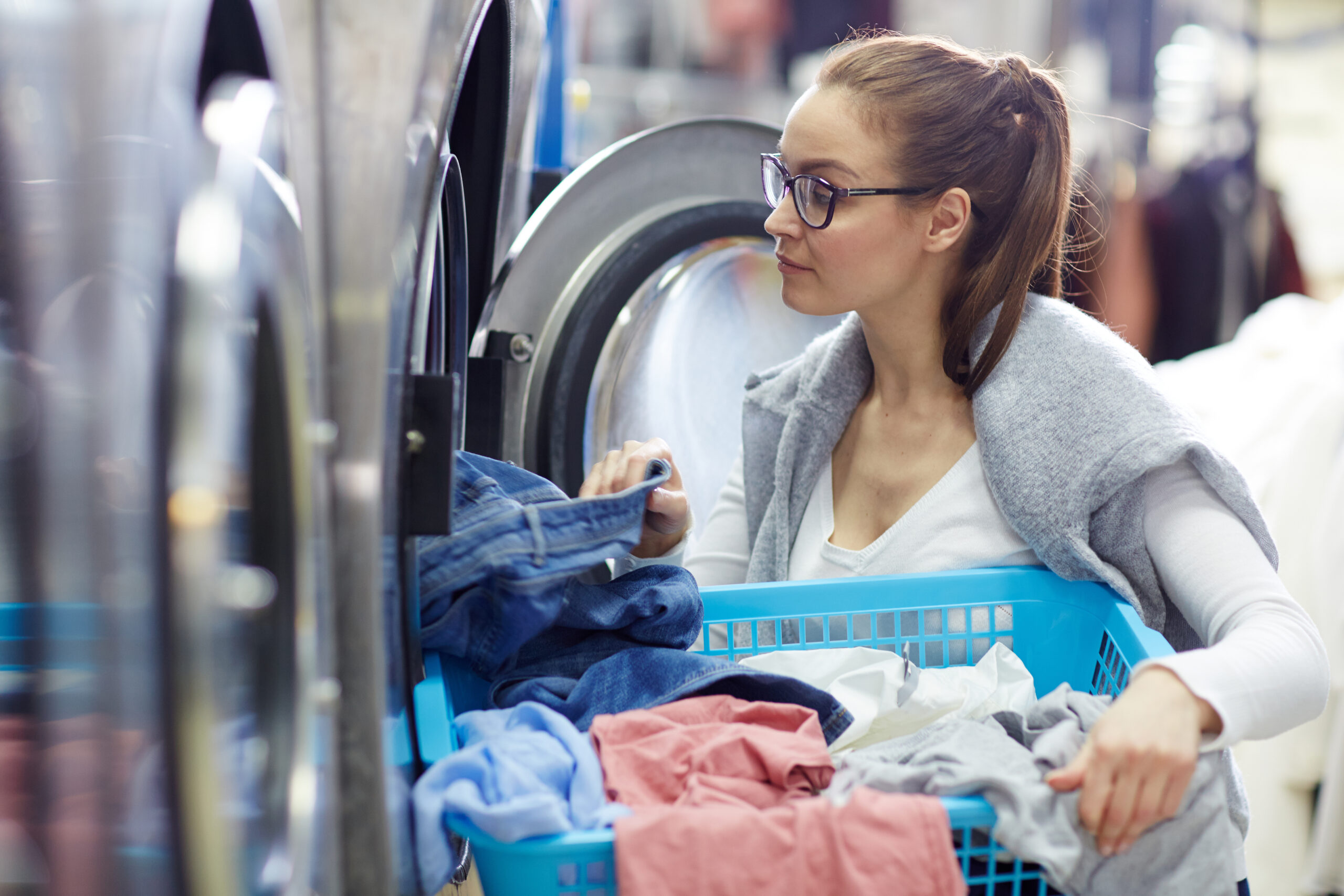Smart laundry equipment is transforming the self-service laundry industry by combining powerful machine performance with intelligent, cloud-connected features. These modern washers and dryers go beyond basic functionality—they communicate with operators in real time, integrate with payment systems, and provide users with mobile-friendly convenience.
With smart equipment, laundromats can optimize machine usage, reduce utility waste, improve maintenance scheduling, and provide better service overall. For owners, it means greater efficiency, more control, and stronger long-term profitability.
Smart machines give laundromat owners a competitive edge in a tech-driven world. Unlike traditional equipment, smart washers and dryers are networked, which means they can track usage, diagnose problems, and report performance instantly. These insights help operators make data-driven decisions about pricing, maintenance, and energy management. At the same time, customers benefit from intuitive interfaces, digital payments, and real-time cycle updates via mobile apps. Smart laundry solutions create a better experience for everyone—owners save money and time, while customers gain convenience and trust. It’s no longer just about washing clothes—it’s about offering a seamless service powered by data and automation.
What Is Smart Laundry Equipment?
Smart laundry equipment refers to commercial washers and dryers equipped with digital interfaces and IoT (Internet of Things) connectivity. Key features include:
- Remote machine monitoring
- Dynamic pricing capabilities
- Mobile app integration for customers
- Automatic maintenance alerts
- Real-time usage tracking and reporting
- Energy consumption analytics
These machines are connected, intelligent, and responsive to both owners and customers. They often include built-in Wi-Fi or Ethernet connections, enabling them to sync with cloud-based dashboards. Customers can choose cycles and pay using an app or touchscreen, while owners get a complete view of machine performance from anywhere. Some models even offer programmable cycles tailored to fabric type or energy-saving preferences. The connected nature of these machines means they stay up-to-date with firmware updates, which can introduce new features over time. In a world of rising operational costs and digital convenience, smart laundry equipment is rapidly becoming the industry standard.
Top Benefits of Smart Laundry Equipment
Implementing smart laundry machines in your laundromat offers several advantages:
- Reduced utility costs through energy and water-efficient cycles
- Lower maintenance expenses thanks to predictive diagnostics
- Increased customer satisfaction with mobile-friendly interfaces
- Faster issue detection and resolution
- Real-time data insights for better business decisions
- Flexible pricing and promotional tools
The impact of smart equipment is felt across every part of your laundromat’s operation. By using sensors to optimize water, detergent, and energy usage, these machines significantly reduce utility bills—especially in high-volume environments. Built-in diagnostics detect issues early, cutting down on expensive emergency repairs. For customers, smart machines simplify the laundry process with notifications, custom settings, and cardless payments.
Operators can monitor machine performance and income from their smartphones or laptops, streamlining management and allowing more time for marketing or expansion. You can also experiment with pricing strategies, such as off-peak discounts, using built-in tools. Ultimately, smart equipment helps maximize profitability while enhancing the user experience.
Key Features to Look for in Smart Machines
When evaluating smart laundry equipment, consider these essential features:
- Touchscreen or app-based user interface
- Remote machine monitoring and usage reports
- Flexible pricing controls (by cycle, time, or promotions)
- Predictive maintenance alerts
- Compatibility with mobile payments and loyalty apps
- Cloud-based management dashboards
Not all smart machines are created equal, so knowing what to look for is key. User interfaces should be intuitive for all age groups, offering simple cycle selection and instructions. Owners should have access to a centralized portal that shows machine usage, revenue, and error logs in real time. Flexibility in pricing models can help you balance demand and improve profitability—such as charging more during peak hours or less during slow times.
Mobile integration is essential for today’s customers, especially Gen Z and Millennials who prefer digital payment over coins. Maintenance alerts can notify you of potential issues before they become costly breakdowns. A well-rounded machine will support all of these functions and adapt to future technology trends.
How Smart Equipment Improves Maintenance and Uptime
Smart machines use built-in diagnostics and connected software to:
- Detect early signs of mechanical issues
- Send automatic service alerts to owners or technicians
- Track usage patterns to schedule preventative maintenance
- Reduce downtime with faster troubleshooting
- Log historical machine performance data
- Enable remote resets or adjustments in some models
The ability to monitor and maintain machines remotely is a game-changer for laundromat owners. Traditional machines often fail without warning, leading to lost revenue, frustrated customers, and rushed repairs. Smart equipment, on the other hand, flags potential issues in advance—like slow drainage or overheating—and sends alerts to your phone or dashboard. This early warning system allows you to address problems on your schedule instead of during peak hours. Technicians can also pull diagnostic data before arriving, reducing repair time and improving first-visit fixes. Some smart systems even allow remote troubleshooting or cycle restarts, saving trips to the store entirely. Over time, this translates to more uptime, happier customers, and fewer repair emergencies.
Enhancing Customer Experience with Smart Technology
Customers using smart laundry machines benefit from:
- Mobile notifications when cycles are complete
- Ability to pay with apps, cards, or QR codes
- Easy-to-understand digital displays
- Loyalty rewards or discounts integrated into accounts
- Less waiting due to machine availability updates
- Cycle customization based on garment types
Smart machines make doing laundry faster, easier, and more enjoyable for your customers. Instead of waiting around for machines to finish, users can get automatic alerts on their phones when their laundry is done. Payment is frictionless, with options for Apple Pay, credit cards, or app-based balances—no more fumbling for quarters. Digital displays guide users through cycle choices, detergent recommendations, and even upsell options like extra rinse or fast dry. By offering loyalty points and promos, you can reward frequent users and keep them coming back. Visibility into machine availability through the app also reduces frustration and time spent in-store. The result is a smoother, more modern experience that builds customer loyalty and satisfaction.
Smart Equipment and Operational Efficiency
Laundromat owners and operators can use smart equipment to:
- Track hourly usage and identify peak periods
- Monitor revenue by machine and location
- Adjust pricing in real time based on demand
- Reduce energy consumption with cycle optimization
- Manage multiple locations from a single platform
- Automate reporting for taxes, payroll, or inventory
Efficiency is the secret weapon of any profitable laundromat—and smart equipment makes it easier to achieve. Data from connected machines helps you identify which hours or days bring in the most revenue, allowing you to align promotions, staffing, or hours accordingly. If some machines are underperforming, you can rotate usage or investigate underlying issues. Dynamic pricing tools let you respond instantly to demand—charging a premium during busy weekends or offering mid-week deals.
You can also cut utility waste by using eco-optimized cycles that automatically adjust based on load size or selected settings. Centralized dashboards mean you can oversee operations remotely, whether you run one store or ten. Automation reduces the time you spend on back-office tasks and gives you more freedom to focus on growth.
Upgrading to Smart Equipment: What to Know
When transitioning to smart machines, keep in mind:
- Initial costs are higher but ROI is strong
- Installation may require infrastructure upgrades
- Staff and customers may need onboarding
- Cloud subscriptions or licensing fees may apply
- Smart features may vary by manufacturer
- Look for scalable systems that support future needs
Making the switch to smart equipment is an investment that pays off—but it requires planning. Upfront costs are higher than traditional machines, though long-term savings in utilities, labor, and maintenance quickly offset the difference. Some locations may need updated wiring, internet access, or router configurations to support connected systems. Training your team—and educating your customers—is critical to a smooth transition.
Don’t forget to budget for any software licensing or cloud access fees that might come with your new platform. Choose a manufacturer with a track record of updates and scalability so your investment stays relevant for years to come. With the right preparation, your upgrade can redefine your entire operation.
Final Thoughts
Smart laundry equipment is reshaping the way laundromats operate—and how customers experience clean clothes.
As competition increases and customer expectations evolve, smart equipment gives you the tools to stay ahead. From operational efficiency and energy savings to better service and streamlined payments, these machines deliver value on every front. They allow you to monitor, adjust, and grow with precision. Customers, in turn, get convenience, transparency, and control—all through their phones or a friendly touchscreen. Whether you’re launching a new laundromat or modernizing an existing one, smart equipment isn’t just the future—it’s the present. And the businesses that adopt it early will lead the way in performance, profitability, and customer satisfaction.




